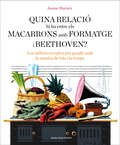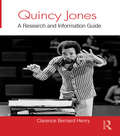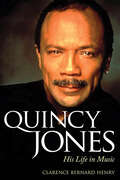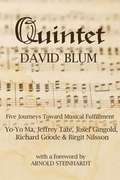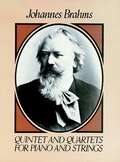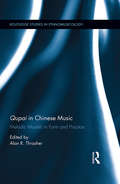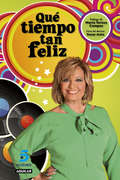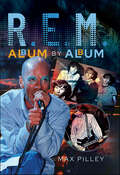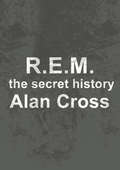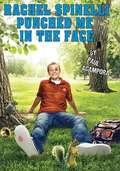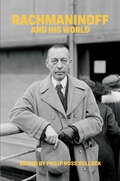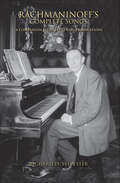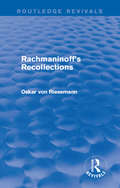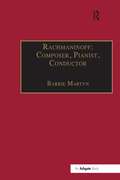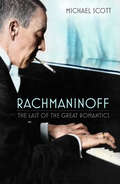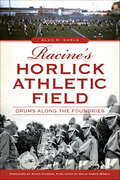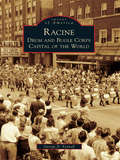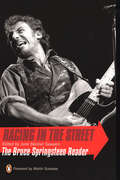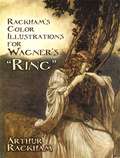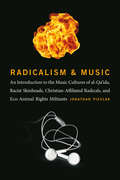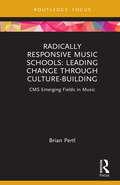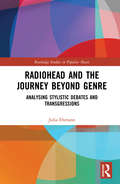- Table View
- List View
Quina relació hi ha entre els macarrons amb formatge i Beethoven?: Les millors receptes per gaudir amb la música de tots els temps
by Jaume BiarnésUn llibre de cuina que ens fa viatjar a través de la música de tots els temps. 30 receptes senzilles i saboroses que dialoguen amb les melodies més exquisides. Quina relació hi ha entre els macarrons amb formatge i Beethoven, el consomé i Verdi o les últimes creacions del Celler de Can Roca i la música d'Erik Satie? <P><P>La història de la cuina i la de la música ha seguit camins paral·lels. En cada moment històric i en cada indret del món, compositors i cuiners han compartit una mateixa manera de veure el món i han desenvolupat les seves creacions amb un esperit comú. En aquest llibre, Jaume Biarnés explora la relació entre la gastronomia i la música a partir de trenta receptes que estableixen un diàleg entre aquests dos mons. Algunes oblidades durant anys en vells llibres de cuina, d'altres, creacions dels xefs més actuals. <P>Des dels primers receptaris de l'antiguitat fins a les més agosarades partitures dels nostres temps, l'autor ens convida a degustar i a escoltar d'una manera fàcil i deliciosa.
Quincy Jones: A Research and Information Guide (Routledge Music Bibliographies)
by Clarence Bernard HenryQuincy Jones: A Research and Information Guide is an annotated bibliography and discography on one of the most prolific composers, arrangers, and conductors in American music. This reference work will appeal to wide range of musicologists, ethnomusicologists and cultural studies scholars.
Quincy Jones: His Life in Music (American Made Music Series)
by Clarence Bernard HenryQuincy Jones (b. 1933) is one of the most prolific composers, arrangers, bandleaders, producers, and humanitarians in American music history and the recording and film industries. Among pop music fans he is perhaps most famous for producing Michael Jackson's album, Thriller. Clarence Bernard Henry focuses on the life, music, career, and legacy of Jones within the social, cultural, historical, and artistic context of American, African American, popular, and world music traditions. Jones's career has spanned over sixty years, generating a substantial body of work with over five hundred compositions and arrangements. The author focuses on this material as well as many of Jones's accomplishments: performing as a young trumpeter in the bands of Lionel Hampton and Dizzy Gillespie, becoming the first African American to hold an executive position in the competitive white-owned recording industry, breaking racial barriers as a composer in the Hollywood film and television industries, producing the best-selling album of all time, and receiving numerous Grammy Awards. The author also discusses many of Jones's compositions, arrangements, and recordings and his compositional study in France with legendary teacher Nadia Boulanger. In addition, details are provided about Jones's distinct ability as one of the most innovative composers and arrangers who incorporates many different styles of music, techniques, and creative ideas in his compositions, arrangements, and film scores. He collaborated with an array of musicians and groups such as Louis Armstrong, Duke Ellington, Miles Davis, Ella Fitzgerald, Sarah Vaughan, Frank Sinatra, Clifford Brown, Ray Charles, Michael Jackson, USA for Africa, and many others. Clarence Bernard Henry shows how Jones has, throughout his career, wholeheartedly embraced philosophies of globalization and cultural diversity in his body of work, collaborations, humanitarian projects, and musical creativity.
Quintet
by David BlumQuintet presents compelling portraits of five artists known and loved by aficionados of classical music: the cellist Yo-Yo Ma, the conductor Jeffrey Tate, the violinist Josef Gingold, the pianist Richard Goode, and the opera singer Birgit Nilsson. This gracefully written book offers a deeply personal look at the lives of these immensely talented and hard-working performers. The essays grew out of conversations the musicians had with the late David Blum, who was himself distinguished both as a conductor and as an author of books and articles on musical subjects.Certain to delight music enthusiasts, Quintet is a perfect holiday gift.
Quintet and Quartets for Piano and Strings (Dover Chamber Music Scores)
by Johannes BrahmsBy 1853 Brahms had emerged as a force in music and would afterward be acknowledged as the greatest master of the symphonic form of the last half of the century. In that generation of composers, only Dvořák (for whom he had a special regard and to whom he gave invaluable aid) produced as much chamber music as the prolific Brahms. This prodigious outpouring, perhaps more than any other aspect of Brahms's oeuvre, provides a clear and uninterrupted view of his artistic development.Here reproduced in this handsome, inexpensive volume is a superb selection of chamber works -- masterful compositions by Brahms, written for violin, viola, cello, and piano. Reprinted from the reliable Breitkopf & Härtel edition, they include Quintet in F Minor, Op. 34; the Quartet in C Minor, Op. 25; and Quartet in A Major, Op. 26, distinguished by their variety of moods, gypsy coloring, and richness of ideas; and the Quartet in C Minor, Op. 60, with its somber and foreboding atmosphere.Standards of the repertoire, these four compositions are strongly dramatic, richly inventive, and filled with ingenious thematic transformations. Musicians, music lovers, and any admirer of Brahms will welcome their appearance in this convenient, affordable edition. Large, readable noteheads and ample margins for notations make this excellent volume an important addition to the library of every serious student of chamber music.
Qupai in Chinese Music: Melodic Models in Form and Practice (Routledge Studies in Ethnomusicology)
by Alan R ThrasherPresenting the latest research in the area, this volume explores the fundamental concept of qupai 曲牌, melodic models upon which most traditional Chinese instrumental music (and some vocal music) is based. The greater part of the traditional instrumental repertoire has emerged from qupai models by way of well-established 'variation' techniques. These melodies and techniques are alive today and still performed in 'silk-bamboo' types of ensemble music, zheng 箏, pipa 琵琶 and other solo traditions, all opera types, narrative songs, and Buddhist and Daoist ritual music. With a view toward explaining qupai as a musical system, contributors explore the concept from multiple directions, notably its historic development, patterns of structural organization, compositional usage in Kunqu classical opera, influence on the growth of traditional ensemble and solo repertoires, and indeed on 19th-century European music as well. Related essays examine the use of shan'ge 山歌 folksongs as qupai models in one local opera tradition and the controversial relationship between qupai forms and the metrically-organized banqiang 板腔 forms of organization in Beijing opera. The final three essays are focused upon traditional suite forms in which qupai and non-qupai tunes are mixed, examples drawn from the Minnan nanguan 南管 repertoire, Jiangnan 'silk-bamboo' tradition and the ritual music of North China.This is the first Western-language study on the nature and background of the qupai tradition, and the methods by which model melodies have been varied in creation of repertoire. The volume is essential reading for East Asian music specialists and contributes to the fields of ethnomusicology, musicology, music theory, music composition, and Chinese music and performing arts.
Qué tiempo tan feliz
by María Teresa Campos LuqueQué tiempo tan feliz nos transporta de manera mágica a un pasado que sigue muy presente en nuestras vidas. Las luces y las sombras de artistas, películas, espacios televisivos y canciones que forman parte de la cultura popular de España. ¿Sabías que los «Quince años» del Dúo Dinámico hizo que más de un padre se llevara las manos a la cabeza en los sesenta?, ¿que Los Pecos tuvieron que hacer la mili para dar ejemplo y que Manolo Escobar era conocido no sólo por sus canciones, sino por su forma de besar en el cine? ¿Sabías que María Jiménez fregaba los suelos de las casas en las que le dejaban cantar, que Fórmula V tuvo problemas con la censura, que Arévalo empezó como Bombero torero o que Bustamante es un maniático del orden? Qué tiempo tan feliz reúne para ti los mejores momentos, los más entrañables, divertidos, curiosos, vividos en directo junto a María Teresa Campos, el director del programa, Yusan Acha, el equipo y los invitados, y da cuenta de anécdotas sorprendentes que se revelaron en este espacio por primera vez. Gracias a un estilo ameno rebosante de guiños a un lugar común que nos acerca a pesar de la edad y de las experiencias vividas, Qué tiempo tan feliz nos transporta de manera mágica a un pasado que sigue muy presente en nuestras vidas. Las luces y las sombras de artistas, películas, espacios televisivos y canciones que forman parte de la cultura popular de España y que componen un fresco en el que el ayer y el hoy conviven con naturalidad. La memoria de una época que evoca recuerdos agradables, un tiempo tan feliz. «Este libro bucea en los recuerdos, en la sentimentalidad de los momentos y de las personas que pertenecen a nuestras vidas, en las luces y las sombras de las trayectorias de éxito mientras se acerca al presente, a las generaciones que crecieron con ellos y a las nuevas que tienen interés en descubrir nuestra historia más reciente».María Teresa Campos
R.E.M. Album by Album
by Max PilleyFrom cowering, introverted founders of the alternative rock movement to one of the twenty best-selling American bands of all time, the story of R.E.M. covers three decades, two generations and the passions of millions. First, they lifted a humble, Southern college town into myth, re-calibrating rock music at the moment that it threatened to reach the point of terminal excess, and then, unsatisfied, they carried their progressive ideology right into the heart of mainstream popular culture, selling over 85 million records and winning universal acclaim along the way, totally without compromise. R.E.M. Album by Album tells that story, tracing the band from its formation in 1980 when four young men sought respite from the difficulties of real life by starting a covers band, right up until their eventual split in 2011, shedding new light on the lyrical and musical development of the band as artists, from their esoteric early masterpieces to the moment that they signed the world’s largest ever recording contract. For the very first time, too, we examine the first decade after the band’s demise, scrutinizing the shifting sands of their legacy as the dust settles on one of pop music’s most extraordinary careers.
R.E.M.: The Secret History (The\secret History Of Rock Ser.)
by Alan CrossAlan Cross is the preeminent chronicler of popular music.Here he provides a history of Michael Stipe and R.E.M.This look at the band—"Radio Free Athens"—is adapted from the audiobook of the same name.
Rachel Spinelli Punched Me in the Face
by Paul Acampora[From the front dust Jacket flap] "As the new kid in the small town of Falls, Connecticut, Zachary Beatrice could use a friend. Thanks to Rachel Spinelli, he's about to get a whole lot more. Rachel's got a good heart, but she can be ferocious if you taunt her brother, and she's not afraid to throw a punch when necessary. For Zachary, life back in Copper Lake, Colorado, was certainly never this exciting! Now, instead of an isolated existence on the edge of town, he's in the midst of all the action, chatting with regulars at the local diner, playing the trumpet as though his life depended on it, and warding off the punches that inevitably come his way. Best of all, he's figuring out that when life punches you in the face, you just get back on up. From the author of Defining Dulcie, comes a novel about new beginnings, the power of forgiveness, and the quirky people that make life interesting." If you enjoyed this funny, story of real kids working at fitting in to their everchanging world, read Defining Dulcie by this author which is in the Bookshare collection.
Rachmaninoff and His World (Bard Music Festival)
by Philip Ross BullockA biography of composer Sergei Rachmaninoff, published in collaboration with the Bard Music Festival. One of the most popular classical composers of all time, Sergei Rachmaninoff (1873–1943) has often been dismissed by critics as a conservative, nostalgic holdover of the nineteenth century and a composer fundamentally hostile to musical modernism. The original essays collected here show how he was more responsive to aspects of contemporary musical life than is often thought, and how his deeply felt sense of Russianness coexisted with an appreciation of American and European culture. In particular, the essays document his involvement with intellectual and artistic circles in prerevolutionary Moscow and how the form of modernity they promoted shaped his early output. This volume represents one of the first serious explorations of Rachmaninoff’s successful career as a composer, pianist, and conductor, first in late Imperial Russia, and then after emigration in both the United States and interwar Europe. Shedding light on some unfamiliar works, especially his three operas and his many songs, the book also includes a substantial number of new documents illustrating Rachmaninoff’s celebrity status in America.
Rachmaninoff and His World (Bard Music Festival)
by Philip Ross BullockA biography of composer Sergei Rachmaninoff, published in collaboration with the Bard Music Festival. One of the most popular classical composers of all time, Sergei Rachmaninoff (1873–1943) has often been dismissed by critics as a conservative, nostalgic holdover of the nineteenth century and a composer fundamentally hostile to musical modernism. The original essays collected here show how he was more responsive to aspects of contemporary musical life than is often thought, and how his deeply felt sense of Russianness coexisted with an appreciation of American and European culture. In particular, the essays document his involvement with intellectual and artistic circles in prerevolutionary Moscow and how the form of modernity they promoted shaped his early output. This volume represents one of the first serious explorations of Rachmaninoff’s successful career as a composer, pianist, and conductor, first in late Imperial Russia, and then after emigration in both the United States and interwar Europe. Shedding light on some unfamiliar works, especially his three operas and his many songs, the book also includes a substantial number of new documents illustrating Rachmaninoff’s celebrity status in America.
Rachmaninoff and His World (Bard Music Festival)
by Philip Ross BullockA biography of composer Sergei Rachmaninoff, published in collaboration with the Bard Music Festival. One of the most popular classical composers of all time, Sergei Rachmaninoff (1873–1943) has often been dismissed by critics as a conservative, nostalgic holdover of the nineteenth century and a composer fundamentally hostile to musical modernism. The original essays collected here show how he was more responsive to aspects of contemporary musical life than is often thought, and how his deeply felt sense of Russianness coexisted with an appreciation of American and European culture. In particular, the essays document his involvement with intellectual and artistic circles in prerevolutionary Moscow and how the form of modernity they promoted shaped his early output. This volume represents one of the first serious explorations of Rachmaninoff’s successful career as a composer, pianist, and conductor, first in late Imperial Russia, and then after emigration in both the United States and interwar Europe. Shedding light on some unfamiliar works, especially his three operas and his many songs, the book also includes a substantial number of new documents illustrating Rachmaninoff’s celebrity status in America.
Rachmaninoff's Complete Songs: A Companion with Texts and Translations (Russian Music Studies)
by Richard D. SylvesterSergei Rachmaninoff—the last great Russian romantic and arguably the finest pianist of the late 19th and early 20th centuries—wrote 83 songs, which are performed and beloved throughout the world. Like German Lieder and French mélodies, the songs were composed for one singer, accompanied by a piano. In this complete collection, Richard D. Sylvester provides English translations of the songs, along with accurate transliterations of the original texts and detailed commentary. Since Rachmaninoff viewed these "romances" primarily as performances and painstakingly annotated the scores, this volume will be especially valuable for students, scholars, and practitioners of voice and piano.
Rachmaninoff's Recollections (Routledge Revivals)
by Oskar von RiesemannThis book, first published in 1934, contains the recollections of the varied and coloured life of a great pianist and composer, who is one of the most striking figures of the musical world. Rachmaninoff dictated his memoires to the author of this book, and much of the story is therefore told in the first person. The final chapter is Riesemann’s own contribution. It is an estimate of Rachmaninoff’s qualities as composer; it shows knowledge of all his more important works; and it shows discrimination. The whole book is an authoritative and interesting study of a popular artist.
Rachmaninoff: Composer, Pianist, Conductor
by Barrie MartynThis study is the first to consider all three of Rachmaninoff's careers in detail. After surveying his place in Russian musical history and his creative activity, the author examines, with musical examples, each working chronological order against the background of the composer's life. Among the the many subjects upon which new light is shed are the operas, the songs, and the religious music. Rachmaninoff's remarkable career as a pianist, his style of playing and repertoire are analysed along with his historically important contribution to the gramophone and his work for the reproducing piano. The book includes a survey of his activity as a conductor. There are extensive references to Russian sources and the first appearance of a complete Rachmaninoff disconography is included. This book is the only comprehensive study in any language of the three aspects of Rachmaninoff's musical career and is a stimulating read for music lovers everywhere.
Rachmaninoff: The Last of the Great Romantics
by Michael ScottThe musical child of Russia’s golden age, Sergei Rachmaninoff, was the last of the great Romantics. Scorned by the musical establishment until very recently, his music received hostile reviews from critics and other composers. Conversely, it never failed to find widespread popular acclaim, and today he is one of the most popular composers of all time.Biographer Michael Scott investigates Rachmaninoff’s intense and often melodramatic life, following him from imperial Russia to his years of exile as a wandering virtuoso and his death in Beverly Hills during the Second World War, worn out by his punishing schedule.In this remarkable biography which relates the man to his music, Michael Scott tells the colourful story of a life that spanned two centuries and two continents. His original research from the Russian archives, so long closed to writers from the West, brings us closer to the spirit of a man who genuinely believed that music could be both good and popular, a belief that is now triumphantly vindicated.
Racine's Horlick Athletic Field: Drums Along the Foundries (Landmarks)
by Alan R. KarlsLaunched in 1919 by William Horlick, the inventor of malted milk, Horlick Athletic Field has hosted two NFL teams, the Racine Belles professional women's baseball team (immortalized in "A League of Their Own)" and thousands of semiprofessional- and industrial-league games. But it is the drum and bugle corps shows that have made the stadium one of the most iconic landmarks in its corner of the state. From an archive of fond recollection and painstaking record, Alan Karls has pieced together a history of Horlick Athletic Field that justifies the reverence that drum and bugle corps have felt for the place for almost a century.
Racine: Drum and Bugle Corps Capital of the World
by George D. FennellMany activities become short-lived fads. Not so for the drum and bugle corps in Racine. Here, after 150 years, drum and bugle corps activity still flourishes as a proud tradition. Racine is the self-proclaimed drum corps capital of the world. Racine had six competing drum and bugle corps during the 1960s and 1970s--very impressive for a community of 90,000. In fact, it would be difficult to find a longtime resident who is unaware of this activity. Everyone in Racine either was a member of or had family or friends who were members of a drum and bugle corps.
Racing in the Street
by Martin Scorsese June Skinner SawyersFor more than three decades, Bruce Springsteen's ability to express in words and music the deepest hopes, fears, loves, and sorrows of average Americans has made him a hero to his millions of devoted fans. Racing in the Street is the first comprehensive collection of writings about Springsteen, featuring the most insightful, revealing, famous, and infamous articles, interviews, reviews, and other writings. This nostalgic journey through the career of a rock-'n'-roll legend chronicles every album and each stage of Springsteen's career. It's all here--Dave Marsh's Rolling Stone review of Springsteen's ten sold-out Bottom Line shows in 1975 in New York City, Jay Cocks's and Maureen Orth's dueling Time and Newsweek cover stories, George Will's gross misinterpretation of Springsteen's message on his Born in the USA tour, and Will Percy's 1999 interview for Double Take, plus much, much more.
Rackham's Color Illustrations for Wagner's "Ring"
by Arthur Rackham James SperoBy the time he created these images, Rackham was England's leading illustrator, famous throughout the world for his interpretations of fairy tales and myths. These illustrations from the original 1911 and 1912 editions, widely regarded as the greatest representations of Wagner's drama, constitute Rackham's masterworks. 64 full-page color images and 9 vignettes.
Radiation Sounds: Marshallese Music and Nuclear Silences
by Jessica A. SchwartzOn March 1, 1954, the US military detonated “Castle Bravo,” its most powerful nuclear bomb, at Bikini Atoll in the Marshall Islands. Two days later, the US military evacuated the Marshallese to a nearby atoll where they became part of a classified study, without their consent, on the effects of radiation on humans. In Radiation Sounds Jessica A. Schwartz examines the seventy-five years of Marshallese music developed in response to US nuclear militarism on their homeland. Schwartz shows how Marshallese singing draws on religious, cultural, and political practices to make heard the deleterious effects of US nuclear violence. Schwartz also points to the literal silencing of Marshallese voices and throats compromised by radiation as well as the United States’ silencing of information about the human radiation study. By foregrounding the centrality of the aural and sensorial in understanding nuclear testing’s long-term effects, Schwartz offers new modes of understanding the relationships between the voice, sound, militarism, indigeneity, and geopolitics.
Radicalism and Music: An Introduction to the Music Cultures of al-Qa’ida, Racist Skinheads, Christian-Affiliated Radicals, and Eco-Animal Rights Militants (Music Culture)
by Jonathan PieslakA comparative study of the music cultures of four radical groups
Radically Responsive Music Schools: Leading Change through Culture-Building (CMS Emerging Fields in Music)
by Brian PertlRadically Responsive Music Schools is a philosophical reimagining of music higher education culture from the ground up, arguing that holistic cultural change is the key factor needed for music schools to prepare 21st-century graduates for contemporary challenges.The author discusses how university and conservatory music programs can incorporate traits they seek to foster in their students – creativity, innovation, improvisation, and entrepreneurial thinking – into the institutions themselves. Through Deep Listening exercises, thought experiments, and other activities, Pertl provides detailed scaffolding for creating music school cultures of belonging and collaboration, wellbeing and intention, curiosity and wonder, creativity and improvisation, and playfulness and joy. Unpacking the complexities of transforming institutional culture, this book envisions the modern school of music as agile, collaborative, and socially aware and outlines pathways for leaders to realize this vision.Radically Responsive Music Schools is an essential resource for college-level music education administrators, professors, students, or staff members interested in how institutional culture can act as a catalyst for radical change in music programs.
Radiohead and the Journey Beyond Genre: Analysing Stylistic Debates and Transgressions (Routledge Studies in Popular Music)
by Julia EhmannRadiohead and the Journey Beyond Genre traces the uses and transgressions of genre in the music of Radiohead and studies the band’s varied reception in online and offline media. Radiohead’s work combines traditional rock sounds with a unique and experimental approach towards genre that sets the band apart from the contemporary mainstream. A play with diverse styles and audience expectations has shaped Radiohead’s musical output and opened up debates about genre amongst critics, fans, and academics alike. Interpretations speak of a music that is referential of the past but also alludes to the future. Applying both music- and discourse-analytical methods, the book discusses how genre manifests in Radiohead’s work and how it is interpreted amongst different audience groups. It explores how genre and generic flexibility affect the listeners’ search for musical meaning and ways of discussion. This results in the development of a theoretical framework for the study of genre in individual popular music oeuvres that explores the equal validity of widely differing forms of reception as a multidimensional network of meaning. While Radiohead’s music is the product of an eclectic mixture of musical influences and styles, the book also shows how the band’s experimental stance has increasingly fostered debates about Radiohead’s generic novelty and independence. It asks what remains of genre in light of its past or imminent transgression. Offering new perspectives on popular music genre, transgression, and the music and reception of Radiohead, the book will appeal to academics, students, and those interested in Radiohead and matters of genre. It contributes to scholarship in musicology, popular music, media, and cultural studies.
